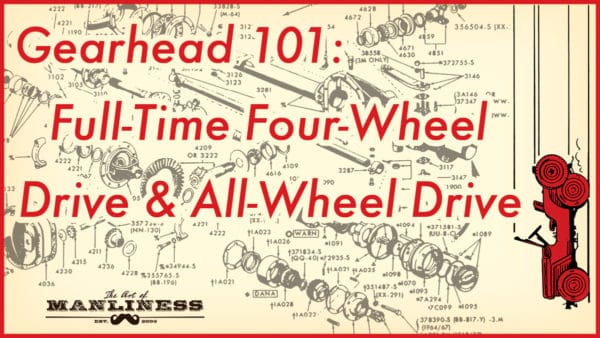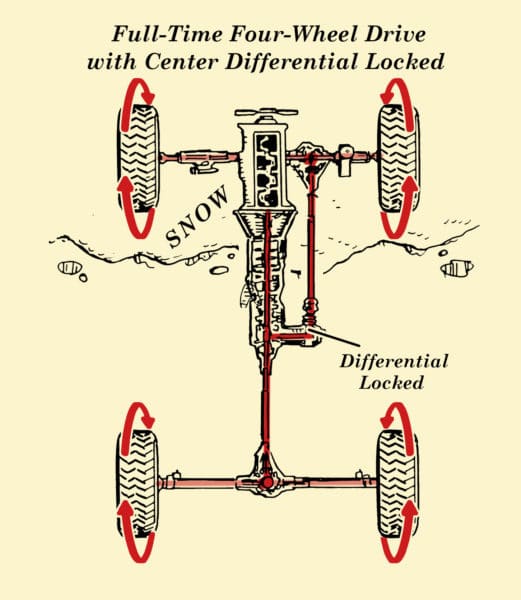
Welcome back to Gearhead 101 — a series on the basics of how cars work for the automotive neophytes out there.
Last time we went into detail about how part-time 4WD works and why it’s beneficial to have all four wheels powering the car in low-traction situations. Today, we tackle full-time 4WD, as well as All-Wheel Drive (aka AWD).
In both drivetrain systems, all four wheels power the car all the time, and as we’ll see, they accomplish that feat using a similar drivetrain arrangement. But there are also some differences between full-time 4WD and AWD, which we’ll explain below.
Let’s get started!
The Benefits and Downsides of Full-time 4WD and AWD
As we discussed in detail in our post about 4WD, one of its benefits over 2WD is that having four wheels moving all the time significantly increases traction in low-traction situations like snow, mud, and loose dirt. If, say, your rear wheels hit a low-traction area on the driving surface, your front wheels might be on a high-traction area. With them receiving power, they can help keep your vehicle moving rather than your rear wheels just spinning while your car stays stationary.
All well and good, but why would you want all four wheels receiving power from the engine even under normal driving conditions? Why would you want 4WD on full-time, instead of just turning it on when needed?
The primary reason is improved handling. Having all four wheels moving the car allows it to take corners better and provides better directional stability when the car is moving in a steady state condition. Improved handling in normal driving conditions results in a safer drive. The improved handling benefit is one reason why you see AWD on sports cars and luxury sedans.
Another reason is convenience. Let’s say you’re driving on a road that has segments of ice and snow but is mostly dry. Instead of having to engage and disengage your part-time 4WD when you hit and leave those slick spots, with the four wheels going all the time, you don’t have to think about it. You just drive.
The big downside of full-time 4WD and AWD is that they use much more fuel than part-time 4WD because the engine has to transfer power to all four wheels, all the time.
How Full-time 4WD and AWD Work
So full-time 4WD and AWD have all four wheels moving the car all the time. But that raises the question: How do these drivetrain systems do that without jacking up the car when driving on high-traction driving surfaces?
As we discussed in the article about part-time 4WD, when you engage 4WD, the transfer case locks the front and rear drive shafts together. They send the same amount of power, or RPM, to the front and rear differentials. When making a turn on dry pavement the front wheels are forced by good traction and geometry to rotate faster than the rear wheels. But because the front drive shaft is going the same speed as the rear drive shaft, a large amount of tension is created that can eventually lead to what’s called drivetrain binding or windup. This can seriously damage your car.
So how do full-time 4WD and AWD avoid this problem?
By adding a third differential in the middle of the drivetrain.
Just like on part-time 4WD vehicles, full-time 4WD and AWD have both a front and rear differential on the front and rear axles that allows the left and right wheels to move at different speeds when making a turn. This prevents the wheel skip that would occur with all four wheels moving.

To prevent the drivetrain binding that would occur due to the different speeds the front and the rear wheels need to go when making a turn, a center differential is placed between the front and rear drive shafts. This allows the front and rear drive shafts to send power to both the front and rear wheels, but allows them to move at different speeds when making a turn. Drivetrain binding problem solved.
So the center differential is what allows full-time 4WD and AWD to send power to all four wheels at the same time, all the time.
What’s the difference, then, between full-time 4WD and AWD?
What Makes Full-Time 4WD Not AWD: A Locking Center Differential
Most of the time, full-time 4WD works pretty much the same way as AWD: the center differential sends engine power to both the front and rear wheels all the time. The center differential allows the front and rear drive shafts to move at different speeds, allowing the vehicle to operate normally, even when making turns on normal driving surfaces.
But by allowing the wheels to move at different speeds, you sacrifice some traction in the process, particularly in low-traction conditions like mud, snow, and dirt. This is particularly the case if the center differential is an open differential. Recall from our previous article that the power flow of open differentials follows the path of least resistance. In low-traction settings, this is no bueno. Here’s why.

Let’s say you’re in a full-time 4WD or AWD vehicle with a center open differential. You’re driving up your driveway, and the front wheels hit a patch of icy snow. You think “I’ve got AWD! This shouldn’t be a problem.†But it is. Those front wheels have the least amount of traction, and consequently represent the path of least resistance. So the center differential is going to send all the power to the front wheels, causing them to spin in place while your rear wheels just sit there on dry pavement not moving at all. To get up the driveway, it’d be nice to have those rear wheels getting some power.
To solve this problem, most full-time 4WD and AWD vehicles use a limited-slip (LSD) or Torsen center differential. These types of differentials give you the benefit of open center differentials — allowing the front and rear wheels to move at different speeds when making a turn on dry pavement — but when one set of wheels hits a slick part, instead of sending all the power to those wheels, it will still send some power to the ones on dry pavement.
So in our snowy driveway scenario, a full-time 4WD or AWD vehicle with a center LSD would send some of the engine’s power to the rear wheels that have traction instead of all of it to just the front wheels that have no traction, allowing you to get your car up the driveway.
Limited slip differentials definitely improve traction compared to open differentials. For most 4WD scenarios, LSDs are all you need for adequate traction. But LSDs still don’t provide optimal traction because most of the power is still going to the wheels with less traction. There’s still a chance of wheel slip.
This is where full-time 4WD separates itself from AWD. Full-time 4WD vehicles have a locking center differential that’s built into the transfer case. When a driver engages it, the center differential locks the front and rear drive shafts together so that they turn at the same speed thus delivering equal amounts of torque to the rear and front wheels. Basically, a full-time 4WD vehicle with the center differential locked acts like a part-time 4WD vehicle when the 4WD is engaged.

In our snowy driveway scenario, a full-time 4WD vehicle with the center differential locked will send equal amounts of power to both the front and rear wheels. Instead of the rear wheels not moving at all (like on an open center differential), or just a bit (like on a center LSD), the rear wheels will be moving at a good clip, allowing you to get your vehicle safely up the driveway.
Some full-time 4WD vehicles increase the traction capabilities in low-traction settings by having options to lock the rear differential, or even both the front and rear differentials, turning the vehicle into a true 4×4.
Many full-time 4WD vehicles also have the option to shift to Lo-gear, allowing you to deliver more power to your wheels while going at lower speeds.
Just as you wouldn’t want to have both front and rear drive shafts moving at the same speed in a part-time 4WD vehicle when on normal driving surfaces, you don’t want them moving at the same speed in a full-time 4WD vehicle when on normal driving surfaces either. You’ll want to disengage the locked center differential when you’re on high-traction surfaces.
AWD vehicles don’t have the option for a locking center differential, so they don’t provide as much traction in slippery scenarios as 4WD vehicles. While AWD can help improve handling on normal driving surfaces, and can improve traction on rainy roads and a bit on snow-covered roads, you wouldn’t want to take an AWD vehicle off-roading. That’s what trusty 4WD is for.
Well, there you go. The basics of how full-time 4WD and AWD work. With that, we’ve pretty much covered the drivetrain on a car. Next up in our Gearhead 101 series: the transmission.
Tags: Cars

